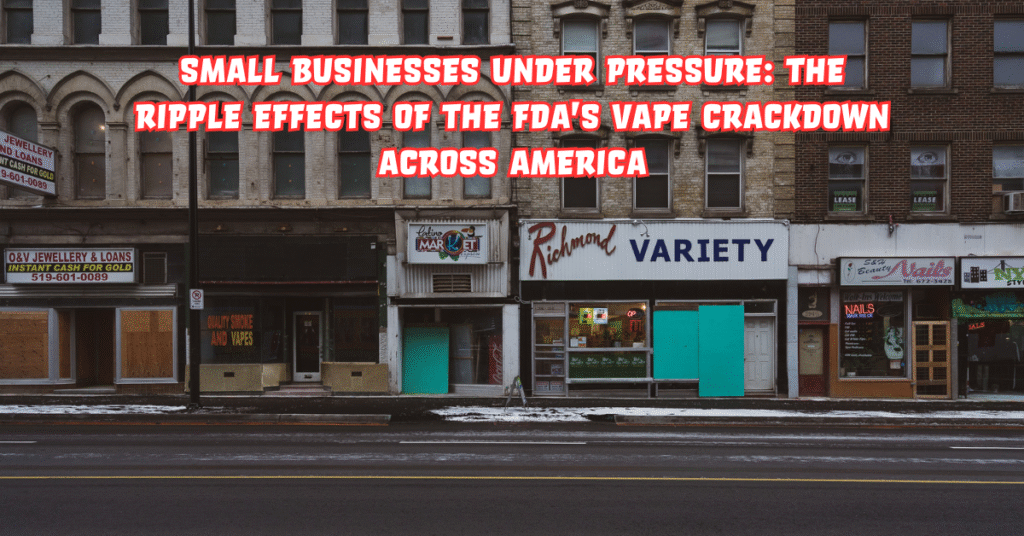In the unfolding story of public health regulation in the United States, few industries have experienced such a dramatic shift as the vaping sector. Over the past decade, e-cigarettes and vape products have evolved from fringe novelties to billion-dollar enterprises. Yet, as the U.S. Food and Drug Administration (FDA) intensifies its regulatory grip on vaping, small businesses—once the beating heart of this industry—are facing a storm of existential challenges.
In the first hundred words, the answer to the searcher’s intent is clear: the FDA’s vape crackdown is reshaping the entire landscape of small vaping enterprises. From product bans and costly licensing hurdles to supply shortages and consumer uncertainty, independent retailers and manufacturers are bearing the brunt of a policy designed to protect public health but inadvertently stifling entrepreneurship.
While the crackdown aims to curb youth vaping and unregulated nicotine products, its ripple effects extend beyond public health debates. For thousands of small vape shops, distributors, and e-liquid manufacturers, the regulatory push has translated into layoffs, declining sales, and a growing sense of frustration. This article examines how the FDA’s actions are transforming the vape economy—from the corner vape shop to the national supply chain—and what the future might hold for America’s small business owners.
The Backdrop: Why the FDA Intensified Its Vape Oversight
The FDA’s authority over tobacco and nicotine products expanded under the Family Smoking Prevention and Tobacco Control Act of 2009, but it wasn’t until 2016 that e-cigarettes officially fell under this jurisdiction. The agency’s primary goal has been to prevent youth access to nicotine products, a mission fueled by rising reports of teenage vaping and health concerns over unregulated substances.
However, as regulations tightened, small businesses found themselves navigating an increasingly complex web of compliance requirements. Every product—flavored e-liquid, disposable vape, or refill cartridge—now requires FDA approval through the Premarket Tobacco Product Application (PMTA) process. For large corporations with deep pockets, this process is challenging but feasible. For small businesses, it’s a near-impossible financial mountain to climb.
Industry experts estimate that the cost of a single PMTA submission can exceed $400,000 per product variation, a sum that few local retailers or small manufacturers can afford. “It’s not just about safety anymore,” says Marcus Hill, owner of a small vape company in Ohio. “It feels like regulation by elimination.”
Table: Regulatory Changes and Their Direct Impact on Small Vape Businesses
| Regulatory Measure | FDA’s Stated Goal | Impact on Small Businesses | Economic Consequence |
|---|---|---|---|
| PMTA approval requirement | Ensure product safety and standardization | High cost of compliance | Closure of small manufacturers |
| Flavor ban enforcement | Reduce youth vaping | Loss of key product lines | Decline in revenue (up to 60%) |
| Online sales restrictions | Limit underage purchases | Reduced consumer reach | Decline in digital sales |
| Import and labeling checks | Curb counterfeit imports | Supply chain delays | Product shortages, price hikes |
| Retail inspections and fines | Strengthen legal enforcement | Increased operational risk | Fines, license revocation |
The Small Business Struggle: Compliance or Collapse
For many small vape shop owners, the FDA’s crackdown has forced an agonizing choice: either invest heavily in compliance or shut down operations. Unlike corporate brands that can hire legal teams to manage applications, independent owners are left with little guidance and few resources.
The application process itself is labyrinthine. Each e-liquid flavor, nicotine strength, and bottle size requires its own PMTA. For shops offering hundreds of variations, the total cost could exceed several million dollars—an unrealistic prospect. As a result, thousands of small vape businesses have already shuttered, unable to meet the bureaucratic demands.
Owners also face the uncertainty of enforcement. Some receive warning letters for selling products deemed unauthorized, even when they were legally manufactured before regulatory updates. Others are fined for labeling discrepancies. The lack of clear communication from regulators has created an environment of fear and confusion.
“We’re not trying to break the law,” says Jennifer Morales, who runs a family-owned vape store in Texas. “We just want fair rules that small businesses can actually follow. Right now, it feels like the system was never designed for us.”
The Economic Ripple: From Retail Counters to Supply Chains
The impact of the FDA’s vaping crackdown is not confined to local shops. It cascades across the entire supply chain—affecting wholesalers, distributors, packaging companies, and even farmers cultivating nicotine-producing crops.
Before the crackdown, the U.S. vaping industry supported an estimated 80,000 small business jobs. By 2025, projections suggest nearly 35% of those jobs may be lost due to regulatory closures and consolidation. This contraction disproportionately affects lower-income entrepreneurs and minority-owned businesses, many of whom entered the industry seeking financial independence.
Vape distributors report significant financial strain as well. Inventory once worth hundreds of thousands of dollars is now unsellable without FDA authorization. Storage costs accumulate, and many companies have had to destroy unsold stock to avoid penalties. The ripple extends even further—to real estate, logistics, and tech sectors that supported the vape economy through shop leases, shipping, and e-commerce platforms.
Table: Economic Indicators Pre- and Post-Crackdown
| Category | 2019 (Pre-FDA Enforcement) | 2024 (Post-Crackdown) | Change (%) |
|---|---|---|---|
| Independent vape shops (U.S.) | 12,000 | 7,800 | -35% |
| Small e-liquid manufacturers | 3,400 | 1,200 | -65% |
| Vape industry employment | 80,000 | 52,000 | -35% |
| Average monthly sales per shop | $48,000 | $27,500 | -43% |
| Consumer product variety | 9,500 flavors | 1,800 flavors | -81% |
The economic contraction reflects not only regulatory pressure but also consumer uncertainty. Shoppers wary of legality or product safety have turned to gray-market alternatives or black-market imports—ironically undermining the very safety goals the FDA intended to achieve.
The Consumer Perspective: When Access Becomes a Challenge
While health advocates applaud the FDA’s actions, consumers—particularly adults using vaping to quit smoking—face fewer choices and higher costs. Many former smokers who successfully transitioned to vaping now report difficulties finding their preferred flavors or brands.
A recent independent survey found that 68% of adult vapers believe the crackdown has limited access to products that helped them quit cigarettes. “Flavors were key to my success,” says David Rowe, a 43-year-old ex-smoker from North Carolina. “When the local shop stopped carrying them, I had to buy from sketchy websites. That can’t be safer.”
This growing underground market poses a public health paradox: while the FDA seeks to ensure safety through regulation, excessive restrictions may drive consumers toward unregulated and potentially dangerous sources.
The Unintended Consequences: The Rise of the Black Market
As legitimate small businesses shut down, the vacuum has been quickly filled by unauthorized online sellers and counterfeit products. These vendors, often based overseas, bypass U.S. safety standards entirely. The result is a surge in untested vape liquids and devices entering the market through illegal channels.
Law enforcement agencies have reported a 30% increase in seizures of counterfeit vape products since 2022. These items often contain impurities, mislabeling, or dangerously high nicotine levels. Ironically, the crackdown meant to protect consumers may have made the industry more hazardous by pushing it underground.
For small retailers who follow the rules, this adds insult to injury. “We’re losing customers to people who don’t care about compliance,” laments Morales. “How do you compete with illegal sellers who face no oversight?”
A Divided Industry: Big Corporations vs. Small Retailers
Another major effect of the FDA’s crackdown is market consolidation. Large corporations—especially those affiliated with tobacco giants—have the financial capacity to navigate the PMTA process, secure approvals, and dominate the market. Small brands, unable to keep up, are either bought out or eliminated.
This consolidation mirrors trends seen in other industries, where regulation often favors scale. Big Tobacco’s vape subsidiaries, for instance, can afford to meet testing requirements and legal fees, allowing them to gain FDA authorization for limited product lines. Independent innovators, however, are locked out.
Critics argue that this outcome undermines the spirit of fair competition. “We’re seeing a shift from community-driven entrepreneurship to corporate monopoly,” says Dr. Helena Strauss, an economist specializing in small business regulation. “The FDA may have unintentionally created the very imbalance it sought to prevent.”
Health and Ethics: Balancing Safety with Economic Reality
The ethical dilemma surrounding the FDA’s vape crackdown lies in balancing public health protection with economic fairness. While it’s undeniable that youth vaping posed a real threat, the question remains whether the regulatory burden on small businesses is proportionate to the problem.
Health advocates defend the FDA’s position, emphasizing that safety must always come first. Yet many acknowledge that the process could be more inclusive. Streamlined, tiered regulations based on company size or risk level could offer a fairer system—one that holds all producers accountable without bankrupting small innovators.
The Role of Innovation and the Future of Harm Reduction
Innovation once defined the vaping industry. Independent developers pioneered nicotine salts, flavor delivery systems, and safety mechanisms that transformed smoking alternatives. Now, that spirit of creativity is stifled under a rigid approval process.
Ironically, this may hinder broader harm-reduction efforts. Public Health England, for instance, has recognized vaping as 95% less harmful than smoking. Yet in the U.S., overregulation risks pushing former smokers back to cigarettes or toward illicit products.
Some advocates call for a “Regulated Innovation Pathway”—a separate framework where small businesses can test and submit products at lower cost under strict oversight. “Safety and innovation are not opposites,” says Dr. Strauss. “They can coexist, but only if policy recognizes diversity in scale.”
Political and Legal Pushback
The FDA’s actions have not gone unchallenged. Industry groups and small business coalitions have filed lawsuits alleging unfair treatment and lack of transparency in the PMTA process. Several state legislatures have also proposed bills to protect local vape businesses, emphasizing job preservation and consumer choice.
In Washington, the issue has become politically charged. Lawmakers from both parties express concern about economic fallout in their constituencies, particularly in areas where vape retail is a major employer. As of 2025, discussions about regulatory reform are ongoing, with calls for a more balanced framework that preserves safety without suffocating enterprise.
The Human Face of the Crackdown
Behind the statistics and legal debates are real stories—of shop owners who poured their life savings into businesses now teetering on the edge, of employees laid off after years of loyal service, and of customers who feel abandoned by a system that once encouraged harm reduction.
One of them is Lisa Coleman, who ran a small vape shop in Denver for eight years. “We built a community,” she says, recalling her now-empty storefront. “People came here to quit smoking, to find support. The FDA didn’t just regulate products—they dismantled hope.”
The Path Forward: Toward Smarter Regulation
Experts argue that reform is both possible and necessary. The future of small vape businesses depends on a more nuanced regulatory approach that distinguishes between responsible retailers and bad actors.
Proposals include:
- Tiered PMTA Costs: Scaled fees based on company size and production volume.
- Streamlined Flavor Testing: Allowing pre-approved flavor bases to reduce redundancy.
- Small Business Grants: Financial assistance for safety testing and documentation.
- Enhanced Transparency: Clearer communication channels between the FDA and industry.
Such measures could preserve public health goals while ensuring economic inclusivity.
Conclusion: A Turning Point for Policy and People
The FDA’s vape crackdown was born from good intentions—to protect the nation’s youth and ensure product safety. Yet in execution, it has sparked a profound crisis for small businesses, reshaping an industry that once thrived on innovation, accessibility, and entrepreneurship.
As policymakers weigh public health against economic sustainability, the stories of small business owners echo a broader truth: regulation without proportionality can extinguish the very diversity it seeks to safeguard. The challenge now lies in finding balance—between safety and survival, oversight and opportunity.
In the words of one former retailer, “We don’t fear rules; we fear being erased.”
If the next chapter of America’s vaping story is to be written responsibly, it must ensure that both lives and livelihoods are preserved.
FAQs
1. Why did the FDA initiate a vaping crackdown?
The FDA aimed to address youth vaping, ensure product safety, and regulate nicotine levels across all e-cigarette products under consistent standards.
2. How have small businesses been affected?
Thousands of small vape shops and manufacturers have closed due to high compliance costs and the complex PMTA approval process.
3. What are the economic impacts of the crackdown?
The crackdown led to job losses, reduced consumer access, and market consolidation favoring large corporations over local retailers.
4. Are all vape flavors banned in the U.S.?
While not all flavors are banned, most flavored products require FDA authorization, leading to reduced availability of popular options.
5. What is the proposed solution for small businesses?
Experts recommend tiered regulation, affordable compliance pathways, and clearer communication between the FDA and small enterprises.







